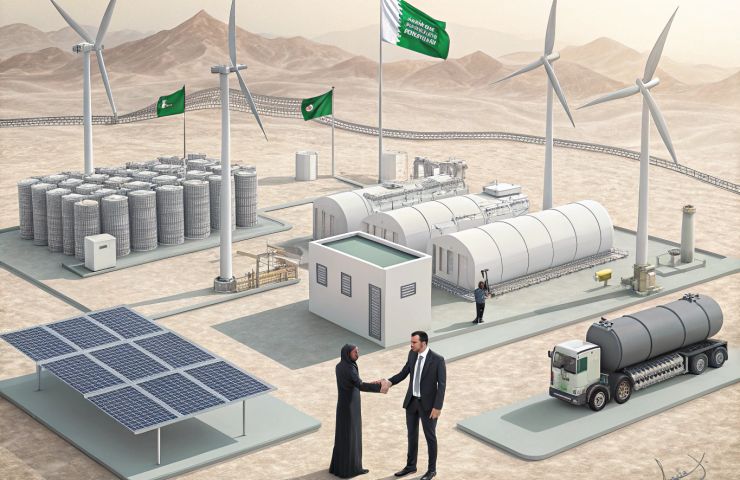
Green Hydrogen Partnership: SARCO and Go Energy to Study Project Feasibility in Saudi Arabia
October 16, 2025On October 11, 2025, Saudi Arabia Refineries Company (SARCO) and UAE-based Go Energy shook hands on a one-year, non-binding MoU to kick the tires on a massive green hydrogen and green ammonia production venture in Saudi Arabia. No cash is on the table just yet—they’re zeroing in on tech feasibility, market dynamics and the legal fine print. It’s the latest in a string of plays by Gulf heavyweights keen to lead on sustainable energy and industrial decarbonization. If everything checks out, this could be the springboard to a bold new era of low-carbon exports.
MoU Highlights
- Who’s teaming up: SARCO (traded on Tadawul) and Go Energy out of Umm Al Quwain, UAE.
- What they’ll do: A year-long feasibility deep dive—everything from site surveys and electrolysis tech pick to offtake markets and rulebooks.
- Money talk: No capex or equity on the line until they greenlight the final investment.
- Where it’s happening: Saudi Arabia, exact spot TBD after maps and soil samples.
- Legal groundwork: Drafting cooperation pacts, offtake deals, and lines of credit with global buyers.
Why It Matters
Let’s face it, demand for hydrogen production and clean ammonia is blasting off as shipping and heavy industry scramble to slash carbon footprints. Saudi Arabia’s got its eye on exporting 1.2 million tonnes of green hydrogen a year by 2030, a headline goal in its National Renewable Energy Program. The trick? Turn sun and wind power into hydrogen via electrolysis, crank that into ammonia, then ship it out through pipelines and tankers already in place.
Industry gurus reckon renewable hydrogen costs could dip under $2/kg by 2030, thanks to cheaper gear and bigger scales. For folks running ammonia plants or shipping lines, that price point could finally stack up against dirty fuels. Europe and East Asia, strapped with tight carbon limits, are already lining up green ammonia offtake contracts, and maritime giants are eyeing ammonia bunkers to power their next-gen, zero-emission vessels.
Technical Dive: Electrolysis and Ammonia Synthesis
Think big electrolyzer farms—probably PEM or alkaline units—drinking power from sprawling solar arrays and wind turbines. These babies split H2O into H2 and O2 with zero on-site CO2 in the mix. Then, that hydrogen feeds right into a Haber-Bosch reactor, hooking up with nitrogen pulled from the air to churn out NH3. What you get is a stable, high-density energy carrier that slots into existing ammonia handling setups, cutting capex and speeding up time to market.
Of course, water’s precious in the desert. The feasibility study will scope out desalination options, water recycling loops and how to plug into the local grid without tripping breakers. They’ll also stress-test electrolyzer durability, energy efficiency and site-specific renewable profiles to make sure nothing slips through the cracks before they pull the trigger on a final investment.
Strategic Angle: Business and Financing
For SARCO, this MoU is a pivot from old-school oil refining to beefing up hydrogen infrastructure and sustainable energy assets. Go Energy chips in with cross-border project chops in renewables and green hydrogen. Together, they’ll trade technical know-how and share the upfront risk. Development banks and export credit outfits are already signalling interest in funding green hydrogen, and Saudi Arabia’s Public Investment Fund could well step in as the anchor investor, bringing patient capital and sweet debt-equity terms.
Comparative Landscape
This MoU follows the blueprint of NEOM’s giant green hydrogen plant—steered by ACWA Power and Air Products—which targets 650 tonnes per day of green ammonia. But SARCO and Go Energy are keeping it lean: nail down feasibility, legal frameworks and offtake deals before splashing out multibillion-dollar capex. It’s a sign the market’s maturing, with data-driven decisions taking center stage.
Alignment with Vision 2030
Saudi Arabia’s Vision 2030 roadmap calls for half of its electricity to come from renewables and a starring role in the global hydrogen production economy, all wrapped up in a net-zero-by-2060 pledge. This MoU slots right into those aims, beefing up a diverse energy mix and bulking up the Kingdom’s clean exports.
Collateral Impacts
- Economic diversification: Less reliance on oil revenues.
- Job creation: Engineers, technicians, legal minds and construction crews.
- Tech transfer: New electrolyzer and Haber-Bosch expertise lands locally.
- Environmental wins: Cuts CO2 compared to grey hydrogen and conventional ammonia.
- Water smarts: Drives low-energy desalination and efficient recycling.
- Community buy-in: Sets the stage for local training and social license.
- Geopolitical edge: Puts Saudi Arabia on the map as a low-carbon export hub.
Next Steps
- Wrap up technical and financial modeling.
- Pin down water sourcing, grid connections and land parcels.
- Draft legal docs—offtake contracts, JV terms, regulatory green lights.
- Woo financiers and lock in potential offtake partners.
- Run environmental and social impact assessments per global standards.
- Hold workshops with local stakeholders.
- Make the go/no-go call or walk away if showstoppers pop up.
About the Companies
SARCO, listed on the Saudi Tadawul, traditionally refines crude oil but is branching out into renewables and green hydrogen, aiming to lead the post-oil economy under Vision 2030.
Go Energy, based in Umm Al Quwain, UAE, develops and invests in renewable energy and green hydrogen projects, forging cross-border partnerships to deliver zero-emission solutions.
It’s still early days, but this tie-up shines a light on a bigger shift: Gulf states are racing to top the hydrogen production leaderboard. As we barrel toward 2030, the feasibility findings will be crunch time—can SARCO and Go Energy raise the bar for green hydrogen projects? Regulators across the Gulf will be all ears, and this could open doors for more joint ventures in the region’s clean energy playbook.



 With over 15 years of reporting hydrogen news, we are your premier source for the latest updates and insights in hydrogen and renewable energy.
With over 15 years of reporting hydrogen news, we are your premier source for the latest updates and insights in hydrogen and renewable energy.